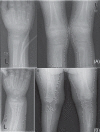Ann Pediatr Endocrinol Metab.
2013 Sep;18(3):152-155. 10.6065/apem.2013.18.3.152.
Refractory rickets caused by mild distal renal tubular acidosis
- Affiliations
-
- 1Department of Pediatrics, Chungbuk National University College of Medicine, Cheongju, Korea. hshan@chungbuk.ac.kr
- KMID: 2266368
- DOI: http://doi.org/10.6065/apem.2013.18.3.152
Abstract
- Type I (distal) renal tubular acidosis (RTA) is a disorder associated with the failure to excrete hydrogen ions from the distal renal tubule. It is characterized by hyperchloremic metabolic acidosis, an abnormal increase in urine pH, reduced urinary excretion of ammonium and bicarbonate ions, and mild deterioration in renal function. Hypercalciuria is common in distal RTA because of bone resorption, which increases as a buffer against metabolic acidosis. This can result in intractable rickets. We describe a case of distal RTA with nephrocalcinosis during follow-up of rickets in a patient who presented with clinical manifestations of short stature, failure to thrive, recurrent vomiting, dehydration, and irritability.
MeSH Terms
Figure
Reference
-
1. Hochberg Z. Rickets: past and present. Introduction. Endocr Dev. 2003; 6:1–13. PMID: 12964422.2. Pettifor JM. Rickets and vitamin D deficiency in children and adolescents. Endocrinol Metab Clin North Am. 2005; 34:537–553. viiPMID: 16085158.
Article4. Kooh SW, Fraser D, Reilly BJ, Hamilton JR, Gall DG, Bell L. Rickets due to calcium deficiency. N Engl J Med. 1977; 297:1264–1266. PMID: 917072.
Article5. Albright F, Burnett CH, Parson W, Reifenstein EC, Roos A. Osteomalacia and late rickets: Various etiologies met on United States with emphasis on that resulting from specific forms of renal acidosis, therapeutic implications for each etiological subgroup, and relationship between osteomalacia and Milkman's syndrome. Medicine. 1946; 25:399–479. PMID: 20278772.
Article6. Rodríguez-Soriano J, Vallo A. Renal tubular acidosis. Pediatr Nephrol. 1990; 4:268–275. PMID: 2205272.
Article7. Nicoletta JA, Schwartz GJ. Distal renal tubular acidosis. Curr Opin Pediatr. 2004; 16:194–198. PMID: 15021201.
Article8. Lemann J Jr, Litzow JR, Lennon EJ. The effects of chronic acid loads in normal man: further evidence for the participation of bone mineral in the defense against chronic metabolic acidosis. J Clin Invest. 1966; 45:1608–1614. PMID: 5927117.
Article9. Rodríguez Soriano J. Renal tubular acidosis: the clinical entity. J Am Soc Nephrol. 2002; 13:2160–2170. PMID: 12138150.10. Batlle D, Haque SK. Genetic causes and mechanisms of distal renal tubular acidosis. Nephrol Dial Transplant. 2012; 27:3691–3704. PMID: 23114896.
Article11. Borthwick KJ, Kandemir N, Topaloglu R, Kornak U, Bakkaloglu A, Yordam N, et al. A phenocopy of CAII deficiency: a novel genetic explanation for inherited infantile osteopetrosis with distal renal tubular acidosis. J Med Genet. 2003; 40:115–121. PMID: 12566520.
Article12. Sly WS, Hewett-Emmett D, Whyte MP, Yu YS, Tashian RE. Carbonic anhydrase II deficiency identified as the primary defect in the autosomal recessive syndrome of osteopetrosis with renal tubular acidosis and cerebral calcification. Proc Natl Acad Sci U S A. 1983; 80:2752–2756. PMID: 6405388.
Article13. Bruce LJ, Cope DL, Jones GK, Schofield AE, Burley M, Povey S, et al. Familial distal renal tubular acidosis is associated with mutations in the red cell anion exchanger (Band 3, AE1) gene. J Clin Invest. 1997; 100:1693–1707. PMID: 9312167.
Article14. Stover EH, Borthwick KJ, Bavalia C, Eady N, Fritz DM, Rungroj N, et al. Novel ATP6V1B1 and ATP6V0A4 mutations in autosomal recessive distal renal tubular acidosis with new evidence for hearing loss. J Med Genet. 2002; 39:796–803. PMID: 12414817.
Article15. Smith AN, Skaug J, Choate KA, Nayir A, Bakkaloglu A, Ozen S, et al. Mutations in ATP6N1B, encoding a new kidney vacuolar proton pump 116-kD subunit, cause recessive distal renal tubular acidosis with preserved hearing. Nat Genet. 2000; 26:71–75. PMID: 10973252.
Article16. Karet FE, Finberg KE, Nelson RD, Nayir A, Mocan H, Sanjad SA, et al. Mutations in the gene encoding B1 subunit of H+-ATPase cause renal tubular acidosis with sensorineural deafness. Nat Genet. 1999; 21:84–90. PMID: 9916796.
Article17. Oduwole AO, Giwa OS, Arogundade RA. Relationship between rickets and incomplete distal renal tubular acidosis in children. Ital J Pediatr. 2010; 36:54. PMID: 20699008.
Article18. Chang CY, Lin CY. Failure to thrive in children with primary distal type renal tubular acidosis. Acta Paediatr Taiwan. 2002; 43:334–339. PMID: 12632787.19. Minari M, Castellani A, Garella S. Renal tubular acidosis associated with vitamin D-resistant rickets. Role of phosphate depletion. Miner Electrolyte Metab. 1984; 10:371–374. PMID: 6095003.
- Full Text Links
- Actions
-
Cited
- CITED
-
- Close
- Share
- Similar articles
-
- A Case of Distal Renal Tubular Acidosis
- A case of distal type of renal tubular acidosis in a neonate
- Distal Renal Tubular Acidosis with Nephrocalcinosis in a Patient with Primary Sjogren's Syndrome
- A Case of Distal Renal Tubular Acidosis Associated with Medullary Sponge Kidney
- A Case of Renal Tubular Acidosis Associated With Graves' Disease




